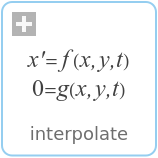WOLFRAM SYSTEM MODELER
interpolateInterpolate linearly in a vector |
|
Wolfram Language

SystemModel["Modelica.Math.Vectors.interpolate"]

Information
This information is part of the Modelica Standard Library maintained by the Modelica Association.
Syntax
// Real x[:], y[:], xi, yi;
// Integer iLast, iNew;
yi = Vectors.interpolate(x,y,xi);
(yi, iNew) = Vectors.interpolate(x,y,xi,iLast=1);
Description
The function call "Vectors.interpolate(x,y,xi)" interpolates
linearly in vectors
(x,y) and returns the value yi that corresponds to xi. Vector x[:] must consist
of monotonically increasing values. If xi < x[1] or > x[end], then
extrapolation takes places through the first or last two x[:] values, respectively.
If the x and y vectors have length 1, then always y[1] is returned.
The search for the interval x[iNew] ≤ xi < x[iNew+1] starts at the optional
input argument "iLast". The index "iNew" is returned as output argument.
The usage of "iLast" and "iNew" is useful to increase the efficiency of the call,
if many interpolations take place.
If x has two or more identical values then interpolation utilizes the x-value
with the largest index.
Example
Real x1[:] = { 0, 2, 4, 6, 8, 10};
Real x2[:] = { 1, 2, 3, 3, 4, 5};
Real y[:] = {10, 20, 30, 40, 50, 60};
algorithm
(yi, iNew) := Vectors.interpolate(x1,y,5); // yi = 35, iNew=3
(yi, iNew) := Vectors.interpolate(x2,y,4); // yi = 50, iNew=5
(yi, iNew) := Vectors.interpolate(x2,y,3); // yi = 40, iNew=4
Syntax
Inputs (4)
| x |
Type: Real[:] Description: Abscissa table vector (strict monotonically increasing values required) |
|---|---|
| y |
Type: Real[size(x, 1)] Description: Ordinate table vector |
| xi |
Type: Real Description: Desired abscissa value |
| iLast |
Default Value: 1 Type: Integer Description: Index used in last search |
Outputs (2)
| yi |
Type: Real Description: Ordinate value corresponding to xi |
|---|---|
| iNew |
Default Value: 1 Type: Integer Description: xi is in the interval x[iNew] <= xi < x[iNew+1] |
